
Feature Story: Women in Technology
Westminster honors tech-savvy women paving the way for a new generation
by Audrey Maynard (’03)
“What are you doing, Barbie?” asks Skipper.
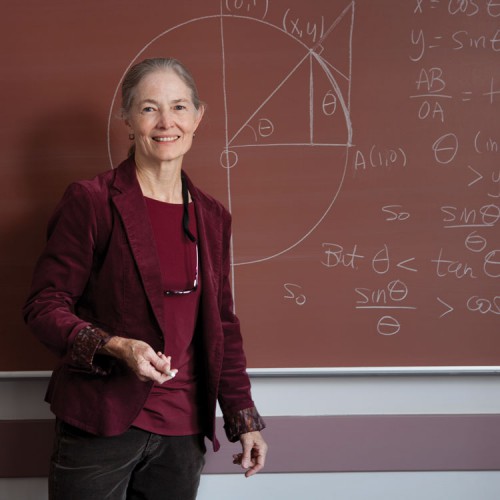
“I’m designing a game that shows kids how computers work,” explains Barbie. “You can make a robot puppy do cute tricks by matching up colored blocks!”
“Your robot puppy is so sweet,” says Skipper. “Can I play your game?”
“I’m only creating the design ideas,” Barbie says, laughing. “I’ll need Steven and Brian’s help to turn it into a real game!”
This excerpt from Barbie: I Can Be…A Computer Engineer reads like a children’s book from the 1950s, but in reality, it depicts the persistent gender stereotype that boys—not girls—are best suited to succeed in science, technology, engineering, and math (STEM).
These stereotypes are fostered early on in elementary school and cemented in popular culture, with most scientists and programmers portrayed by geeky men in film and fiction. Although women earn nearly 60 percent of all bachelor’s degrees nationwide, fewer than 18 percent are pursuing degrees in engineering and computer science.
Westminster professors Helen Hu and Carolyn Connell have spent their careers forging paths for young women in science and math, and their efforts have inspired students, like Sabina Schill and alumna Dayna Stevenson, to blaze trails in STEM—not just because they’re women, but because they can.
Helen Hu:
Growing up in New Jersey, Dr. Helen Hu always knew that she wanted to be a teacher—just not necessarily a computer science teacher. But having a role model in her mother (who was a computer scientist) and learning that she, too, had an aptitude for computer science in her high school programming class, Helen pursued a computer science degree at Princeton and has never looked back.“At Princeton, computer science hadn’t really taken off yet,” she says. “It was a nice small class of 30 students. There were five females in the program, which was pretty close to the average then.”
But studies show that the gender-equity trend among computer science majors is getting worse. Compared to other STEM majors that are seeing the number of female students increase, computer science has experienced a downward trend since the dot- com bust in the early 2000s.
“Computer science numbers were best in the 1980s before the personal computer. Everyone entered college on a level playing field because high schools couldn’t afford personal computers,” Helen says. “Numbers improved again in the late 1990s, but when the dot-com bust happened in the late 1990s, computer science enrollment dropped—and female enrollment dropped a lot more than male.”
Helen began teaching at Westminster around the time these numbers were at their worst. As the sole female faculty member in Westminster’s computer science department, Helen has often taught classes comprising entirely male students. She saw both an opportunity and an obligation to address the problem, but knew that by the time women entered college it would be too late.
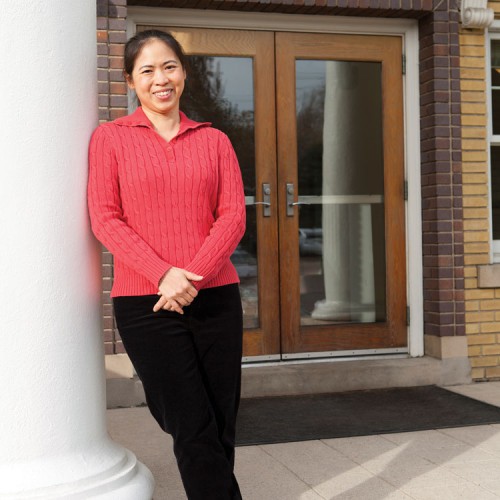
“This problem has to be fixed at the K–12 level,” she says. “We need to make computer science as non-optional as possible. If we make it optional, the students and parents self-select, and you fall into the stereotypes where only white males and Asian males enjoy computer programming.”
So in 2012 (double check date), Helen applied for and received a three-year, $800,000 grant from the National Science Foundation to introduce more computer science options in Utah public high schools. She runs a five-day workshop during the summer for high school teachers interested in teaching “Exploring Computer Science.” At two and a half years in, Helen is on track with her goal of preparing 100 teachers to offer “Exploring Computer Science” to high school students.
For her efforts—which go well beyond her duties as a college professor—Helen received the 2014 Women Tech Award for Education Excellence, given by the Women Tech Council to honor women (with ties to Utah) who are changing the face of technology.
“It’s nice to have the recognition because sometimes it can feel like it’s an uphill battle and we’re not making much progress,” she says. “Part of the reason I won the Women Tech Award, in addition to bringing computer science to so many schools, is that starting this year, computer science counts toward the three sciences you need for high school graduation.”
Helen adds that if computer science meets some kind of high school requirement, female students will be more likely to take it. “And not only female students,” she says. “First-generation students are more likely to take it, and minority students, and, of course, male students. Everything we do to improve computer science education is helping all students who are taking computer science.”
Carolyn Connell:
Math professor Dr. Carolyn Connell has spent her entire career working to inspire young women, in particular, to pursue careers in STEM. Carolyn grew up in a Texas college town and had dreams of following in her father’s footsteps by becoming a physics professor. “My dad expected everything of me that he did of my brothers: he expected me to do well.”
But high expectations weren’t enough to keep Carolyn in the physics program at the University of Texas. The sole woman in the program, Carolyn felt isolated and unwelcome. “Today I would blow it off, but when you’re 18 or 19, those sorts of things affect you,” she says. “I felt invisible, and I didn’t last very long.”
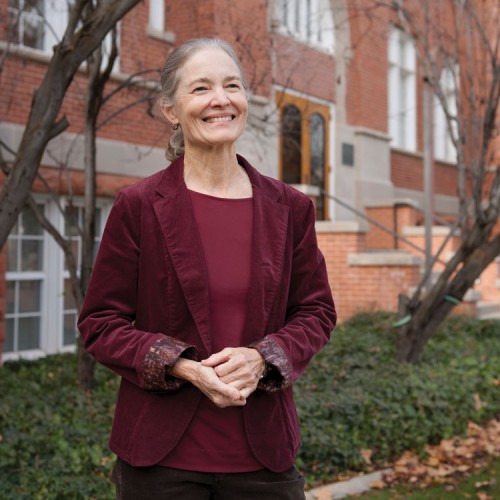
She switched to the mathematics program where one-third of her classmates were female, and she had several female colleagues in her master’s program at North Texas State University. But when she enrolled in the PhD program at the University of Utah, she was the only female native English speaker, and she had no female professors.
As an educator in Utah, Carolyn is concerned by the rate at which women are completing their bachelor’s degrees, not just in STEM majors but across the board. According to the Utah System for Higher Education, Utah ranks last in the percentage of women who earn a four-year degree, and it has the lowest percentage of doctorate and professional degrees awarded to women.
“We have fallen behind in the rate at which women finish college: we’re at or very close to the bottom,” she says. “If you can’t see anybody doing it, and you’ve been told that you can’t do it, and there is no expectation for you to do it…is there any wonder?”
Earlier in her career, Carolyn coordinated STEM workshops at the University of Utah targeted to female high school students. These events were largely for recruiting purposes, so Carolyn, as a Westminster faculty member, felt it was only right to shift her efforts to creating STEM programming at Westminster. She collaborated with the American Association of University Women (AAUW) to create a residential summer camp for girls entering the eighth grade. AWE+SUM (Attend Westminster Explore Science Use Math), now in its eleventh year, offers girls a week of workshops designed to ignite their interest in math and science. More importantly it provides them with female role models—Westminster students and faculty, and women working in STEM fields—to show them that they, too, can have a bright future.
The AWE+SUM program wasn’t designed to be a recruiting tool for the college, though some former campers have become Westminster students. Nor was it intended to convert all attendees to be future scientists. At its core AWE+SUM is designed to inspire girls to excel in school and attend college, and it shows them that math and science are fun and can lead to interesting career opportunities. AWE+SUM draws students from Title 1 schools and from Native American reservations as far away as Shiprock, New Mexico, and about half of the girls attend with full scholarships.
“Getting girls from these backgrounds to even consider going to college is huge. For some girls, it’s about showing them that college is not a threatening place. The idea is to give them exposure, showing them that it’s fun. Getting the girls interested in math and science is just an added benefit,” says Carolyn.
Managing AWE+SUM is mostly a labor of love for Carolyn. She promised her granddaughter ten years ago that she would do it long enough for her to participate, which she’ll have the opportunity to do in June. “It’s been incredibly rewarding. The hardest part is not knowing for sure that you’ve made an impact,” she says. “We hope that all involved—8th grade girls, Westminster female students who work as counselors, Westminster faculty who conduct workshops, and the professional women from the community who serve as mentors—have a sense of ‘we’re all in this together.’ It’s for the well-being of all that we make this effort.”
And, ultimately for Carolyn, she hopes her efforts help inspire the next generation to pursue a growing number of STEM jobs that the current United States workforce is not ready to fill.
“After all, we have a real shortage in this country of people interested in STEM fields,” she says. “For whatever reason a lot of people stay away from them. If you take females—half our population—and you’re not getting some of them involved, when are we ever going to meet the need? It’s not all about jobs; it’s about the self-confidence that you get when you tackle a subject that is challenging and discover that you can do it.”
Dayna Stevenson:
The highly competitive field of video game design is experiencing a boom in popularity at colleges and universities nationwide. In fact, since 2009, the number of postsecondary schools offering gaming-design programs has increased 50 percent (Entertainment Software Association), and the number-two–ranked program hails from just down the road at the University of Utah.
Dayna Stevenson (’13) is one of six women in the current cohort of 50 artists, producers, and programmers in the University’s Entertainment Arts and Engineering program. Dayna, a programmer, did not always know she wanted to be a video game designer, but she credits Westminster’s computer science program for showing her the world of possibilities open to her in computer science.
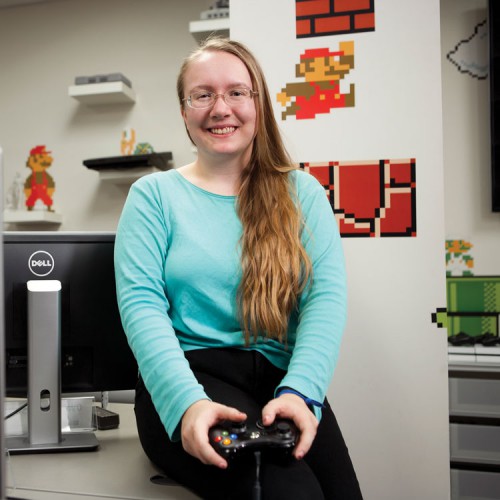
“I knew for sure I wanted to do computer science, but I wasn’t sure what in,” she says. “Westminster was perfect for that. I had classes in artificial intelligence, networks, and databases. The program gave me a good sampling of what I could do.”
Her passion for gaming design was ignited when she took Professor Greg Gagne’s class in software development. During the class she created a product from start to finish, including the development of a marketing plan and a database.
“We made a game that would teach math to elementary students, and I realized that games were amazing,” she says. “It was the only school project that I’ve ever had in my life that everyone in the group pulled their weight and was excited about what they were doing. It was the perfect experience and the most fun I ever had in a class.”
Now in her master’s program, Dayna has been working with a team of five colleagues to produce a game to be judged in the Student Competition category of the Independent Games Festival (winners announced January 2015). “Point and Think” is a point-and-click game that takes the player through a space adventure in which the captain of a spaceship (the player) becomes incapacitated and must rely on manipulating the thoughts of the inexperienced crew to survive.
“We’re interested in that because it brings up the questions of is it moral to see people’s thoughts, and is it moral to try to change them?” she says. “We did a lot of research to see if other games did that, and we couldn’t find them.”
Dayna graduates in May and hopes to work with her younger sister, Jessa, to create an independent game company of their own. They have already designed a spot-the-difference game called “Questian” that they hope to build upon in the coming years.
“I have spoken to a lot of people who work at AAA gaming companies, and I thought initially that’s what I wanted to do,” she says. “But I’d rather stick to the indie side of it because I want to know that I contributed significantly to the game. In AAA companies you can work on a game for three years, but in the end you don’t feel like you had a profound impact on the way a game turns out.”
Last year Dayna was nominated for, and won, the student Women Tech Award. She’s humbled by the prestigious company of which she’s a part. “It meant a lot that I was succeeding in this field enough to receive recognition,” she says. “I look up to women like Helen Hu, and it’s unbelievable to be counted among their ranks.”
But like many of her peers, Dayna looks forward to the day when being a successful woman in a STEM field is no longer a novelty. “I don’t think women should go into technology so there should be equal representation,” she says. “It should be more about people going into fields they’re passionate about. I’m waiting for it to get to the point where it’s about people—not men and women.”
Sabina Schill:
Sabina Schill has always been interested in how things work. As a kid in Middletown, Delaware, Sabina loved constructing car tracks, building Legos sets, and experimenting with electromagnetism kits. She also loved learning from her parents: her mother is a teacher, and her dad spent a lot of time teaching Sabina how to fix up cars.
An interest in paleontology brought Sabina to Utah, but she quickly realized that it was to remain just an interest. Sensing that the University of Utah was too big to be comfortable, she enrolled at Westminster and quickly became a standout student—excelling as a physics major and in the honors program.
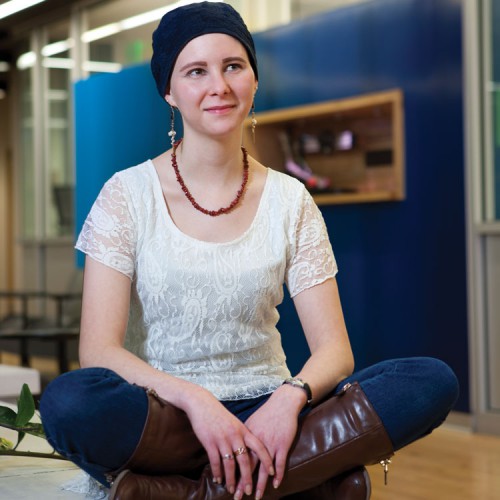
“In honors it’s true when they say, ‘If you can make it through humanities, the rest is comparatively easier!’” she laughs.
Sabina credits Westminster for providing the kind of learning environment that has challenged her to pursue her passions, as well as try things she doubts she would have anywhere else. She remembers a physics class in which she and her classmates tested force by roller skating down the halls of Malouf into a sensor, but she also recalls ballroom dancing in a performing arts class co-taught by Heidi Van Ert and Michael Vought where she “learned to take risks and try something different.”
Perhaps the most important outcome of Sabina’s education is the amount of experience she has acquired through her involvement in undergraduate research. Over the past two summers, Sabina has participated in the National Science Foundation’s Research Experience for Undergrads (REU) program. In 2013, she learned that she does not want to pursue a future in computer programming after using MATLAB to model the movement of electrons in organic cells at South Dakota State University. And last year, she completed her second REU at Louisiana State University, where she made improvements to the Nuclear Physics Group’s gas ionization detector.
“That was one of the great experiences I’ve had, because I got to travel AND I got a stipend,” she says. “I used AutoCAD engineering software to make a 3-D model of the mounting for our new particle detector, and I got to put it together by soldering and drilling—that’s a lot more than I’ve been able to do in class!”
It was during her time in Louisiana that she learned about her nomination for the Women Tech Award by professors Chris Cline and Peter Conwell. “The call was from my mother, so I took it outside, and she was like, ‘I got an email from a Chris Cline and a Peter Conwell, and they need your résumé,’” Sabina says. “I got an email a couple weeks later from the Women Tech Council saying, ‘Congratulations, you are a finalist!’ It was wonderful.”
Sabina graduates in May and plans to study mechanical engineering in a master’s program: the international program at the University of Glasgow is at the top of her list. She is fully aware that she is entering a field dominated by men, but she seems unfazed by that.
“I don’t see physics as something that is particularly difficult. It has its moments, but it’s nothing that I can’t work out,” she says. “People say, ‘Oh, you’re so smart because you do physics,’ and I’m like, ‘There are all those other things I don’t know!”
She adds that the way to address gender disparity in STEM is for women in her generation to pursue what interests them most. “I like physics; I’m good at it,” she says. “It doesn’t matter that I’m the minority. It’s something that I want to do. If you’re the only girl in class, try to get somebody else to join you, and then you’re not the only girl. Just keep going!”
Westminster’s Women Tech Award Recipients and Finalists:
| Helen Hu | Faculty | 2014 | Winner, Education Excellence |
| Sabina Schill | Student | 2014 | Finalist |
| Zlatina Todorova | Alumna | 2013 | Winner, Technical Excellence |
| Dayna Stevenson | Alumna | 2013 | Winner, Academic Excellence |
| Elena Balasa | Student | 2013 | Finalist |
| Kristi Knight | Alumna | 2011 | Finalist |
| Linda Muir | Staff/Alumna | 2010 | Finalist |
| Cindy Sanders | Alumna | 2009 | Finalist |
Fun Facts:
Helen Hu:
Childhood hero: My mom
Class I always wish I had taken: Photography
Continually inspired by: My children
When not teaching, I’m most likely: Binge watching a television series off Netflix
Biggest wish: World Peace (of course)
Carolyn Connell:
Class I always wish I had taken: Spanish
Continually inspired by: My Westminster math colleagues
Least likely to: Leave my dogs at home
Favorite hobbies: Hiking in southern Utah; skiing in the Wasatch
Favorite food: Okra Gumbo (raw okra comes in a close second)
Guilty pleasure: M&M's
Sabina Schill:
Continually inspired by: The students I TA for
Most likely to: Go on vacation just to do Zumba every day
Would love to travel to: Alton Towers, an amusement park in England
Favorite book-turned-movie: Stardust by Neil Gaiman
Secret desire: To build a large Rube Goldberg machine in one of the physics rooms
Dayna Stevenson:
Top role model: Dorothea Lynde Dix
Favorite video game: Skyrim
Class I always wish I had taken: Fencing
Least likely to: Give up
Favorite book: Atlas Shrugged
About the Westminster Review
The Westminster Review is Westminster University’s bi-annual alumni magazine that is distributed to alumni and community members. Each issue aims to keep alumni updated on campus current events and highlights the accomplishments of current students, professors, and Westminster alum.
GET THE REVIEW IN PRINT STAY IN TOUCH SUBMIT YOUR STORY IDEA READ MORE WESTMINSTER STORIES